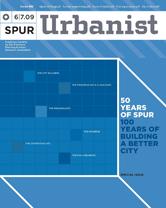Issue 483
to
SPUR Urban Center Grand Opening
50 years of SPUR, 100 years of building a better city
The Ironies of History
Armed with knowledge of the past, how do we move forward with our own urban agenda?
There is a cliché that city planning is simply fixing the mistakes of past planners. And yet, we cannot just sit on the sidelines. We have to learn from past mistakes and approach our activism with a sense of humility about all that we can’t know. But still we must act.
Agents of Change
Civic Idealism and the Making of San Francisco
SPUR's inaugural exhibition, Agents of Change , examines the history of citymaking in San Francisco and frames our current challenges in light of the many successes — and failures — of previous eras. We invite you to meet the people who shaped the city: the City Builders, the Progressives and Classicists, the Regionalists, the Moderns, the Contextualists and the Eco-Urbanists.
Reflections on Preservation
How the past became the future
Since the recession has lowered the pressure on both sides of the development/preservation equation, this time of inactivity could be devoted to the kind of even-handed planning that would mitigate future battles by evaluating the benefits of both.
City of Plans (City of Experiences) in History
What, exactly, makes a "great city"?
The question of how we hold on to the best of a city — architecturally, historically, as a matter of quality of the urban experience and quality of life — is deeply bound to the question of how cities change,and in particular the tension between "preservation" and "development."
Progress Intentionally Planned
Telesis and the Modernist agenda
Telesis' 1942 exhibit, "A Space for Living," inspired the San Francisco Housing Association to expand from housing reform advocacy to a group concerned with city planning overall, renaming itself the San Francisco Planning and Housing Association, which in turn, became SPUR.
